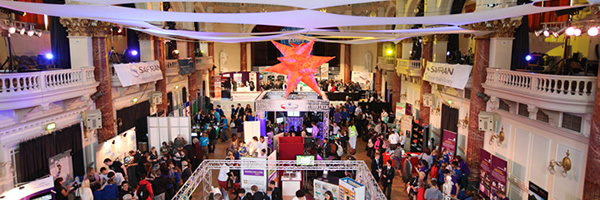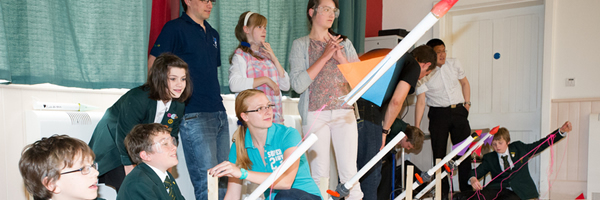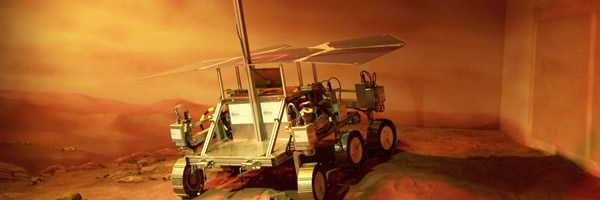The Institution’s Western Region’s many volunteers have recently inspired children at a high profile Science Festival in Cheltenham and hosted some original and stimulating events around the region to raise the profile of engineering and the work of engineers.
The Bath and Bristol Young Members’ Panel (YMP) hosted a night to remember in April: dinner beneath the wings of Concorde at the Fleet Air Arm Museum. As well as a three-course meal, guests enjoyed the opportunity to explore the museum, to network with fellow engineers and to hear the reminiscences of Les Evans, former Concorde pilot, who was the evening’s invited speaker. Over 100 guests enjoyed the event, which was co-ordinated by Kirsty McDonald, of Magnox Sites, and other YMP colleagues.
Kirsty said: “I am really pleased with the success of the evening, it was an amazing location for dinner and the speaker was fantastic. My favourite memory of the evening is when Les, describing a detail on the engine outlets while pointing to his presentation, paused for a moment, then pointed to the same features a couple of feet about his head! We are immensely grateful to AECOM, Assystem, Atkins, Magnox and Schlumberger, who sponsored tables of students.”
In March, Western Region volunteers Charlotte Mercer and Jake Tudge – engineering students at the University of the West of England (UWE) – organised and hosted an Energy Question Time. Five experts from across the energy sector were on the panel, with over 100 professionals and students in the audience. A lively, wide-ranging debate, with much audience interaction, was followed by a networking buffet and a feedback exercise. Jake and Charlotte were widely commended for their organisation of the evening; for raising awareness of the many issues facing energy generation in the future, and for highlighting the work of bodies such as the Institution and the Chartered Institute of Building Services Engineers (CIBSE), which collaborated to support the event. Ed Hammond, chair of the Bath and Bristol YMP stated: “The Energy Question Time was an outstanding success. More events like this will help industry and innovators build a better future.”
Congratulations to Charlotte, who has a place on the graduate programme at AECOM, and Jake, who is taking up a year’s placement with E.ON.
Ian Parsons, Western Region Chair, summed up his thoughts about the ideas and events that have taken place recently. “I have been most impressed by the commitment of volunteers to deliver a varied and informative programme. In particular the young members have shown much enthusiasm and innovation, for which they are to be congratulated. Thank you, in particular, to the many volunteers who supported the Cheltenham Science Festival with such vigour, reinforcing the Institution’s brand and our commitment to improve the world through engineering.”
Ian co-ordinated a stand at the family-friendly Science Festival (4-9 June), which received thousands of visitors. Ably assisted by volunteers from the Bath and Bristol YMP; Magnox; and Defence Equipment and Support (DE&S), the stand was in the large ‘Discover Zone’ in Cheltenham’s Town Hall.

Visitors learned about a range of vehicles, many of which were on show, from a model created by 11-year-olds, to the ‘Team Bath’ Formula Student 2011 entry (and on-screen footage of Bath’s 2013 race car) as well as Bloodhound SSC footage and the ever-popular race car simulator. There was an irresistible opportunity to try out a variety of foldable paper aeroplanes, particularly effective as the Institution’s stand was up on a stage!
Designed by graduates and built by apprentices at DES, two models demonstrated the operation of a gear box. One, a miniature wind turbine; the other a series of cogs, all helped visiting schoolchildren understand the principles of the mechanism. The cogs were easy to change, so visitors could experiment with the models; and facilitators helped explain the concept.
Scott Pickard, who was at the festival with Western Region volunteers for the first time, was one of the 40-strong team who worked on all aspects of the Institution’s presence at the event. Explaining the gear box, he said: “
It was interesting to see how some students already knew some of the principles, and were excited to dig deeper and find out more.” Dave Ford, apprentice supervisor, said:
“The activities have inspired kids. They are seeing that engineering is fun!”
Darren Fillis, from the graduate team at DES, said that taking part was incredibly rewarding: “You can see the STEM philosophy behind engaging non-engineers with everyday engineering practices. This is how to get kids into the subject.”
In addition to activities on the stand, Ian had devised a two-hour workshop entitled ‘International Rescue’, which ran three times during one day. Thirty Key Stage 3 pupils per session, in teams of five, built rockets from materials such as domestic waste pipe and valves and launched them (using foot pumps) to see which would hit the target. The activity was based on real-life principles of sea rescue.

Students were encouraged to be creative with their designs, following a prototype made by Institution and Magnox volunteers. They named their machines and were given the opportunity to adapt the rockets following a test-launch, to improve the height, angle or duration of their best rocket’s flight. In an exciting final round, the winning rockets improved their trajectory and hit point-scoring targets.
As Ian explained, the activity was set up: “To test the students’ understanding of a range of principles, from generating air pressure and harnessing energy to interpreting angles of elevation and modifications to design – as well as all-important team work.”
A volunteer facilitator was available for each team, and the event was managed by mechanical engineer Clare Niesigh AMIMechE of Magnox Sites, from the YMP committee for Bath and Bristol.
Clare explained that the day’s main focus – to engender enthusiasm for engineering through a hands-on competitive project – was having great results: “This practical style of activity means that the kids can create and engage with the application, which fuels their enthusiasm, as they have such a huge stake in making it work. This is what inspired me as a kid – I’d love to be doing it myself, but it’s great taking part as an adult, encouraging the next generation,” she said.
Kingsmead Academy’s attendance had been kindly sponsored by EDF Electricity and the winning rocket (in one of the two workshops the academy’s Year 8 pupils attended) was named ‘Francezka’. Members of the school’s all-girl team from Wiveliscombe, near Taunton, said that they made alterations to make their rocket fly straighter after initial tests, and it was one of the few which struck a target, winning with 30 points.
They understood that different forces were in play to make their rocket win, explaining: “The longest rocket was the winner: we gave it four rather than two fins, and it had more volume, to store more energy, enabling it to fly further.”
Caroline Clements, Kingsmead’s Head of Science and Head of Year 8, said: “Today the students gained the chance to spend a good amount of time experiencing science in real life. It was a great benefit to have young engineers available to facilitate.”
Further events of interest to members of the Institution, which took place at the Cheltenham Science Festival, included an accessible, instructive and often humorous presentation about ‘Autonomous Robots’, and a talk by the Right Hon David Willetts MP, Minister for Universities and Science (who was also one of the festival’s guest directors) exploring the UK’s leading position in ‘Eight Great Technologies’.
Abigail Hutty and the autonomous robots
Abigail Hutty AMIMechE, a structural engineer at Astrium and an associate member of the Institution, is working on the ExoMars Rover Project. Abigail took part in a lively three-way presentation with artificial intelligence and robotics Birmingham University lecturer Nick Hawes, and Professor Alan Winfield from the Bristol Robotics Laboratory. Each brought a robot (or robots) that illustrated how far autonomous robotics has developed, and demonstrated some of the technology’s limitations. Interestingly, two of the robots have names: Astrium’s Bridget (whose ‘relatives’ include Brenda and Bruno) and Dora the Explorer.

The audience kept the presenters on their toes, with questions about the extent to which robots can learn; the use of GPS and other sensors; the possibility of launching from Mars; robots in domestic use and – from one of the youngest attendees – the important query: “Could a robot pick up my dirty socks from the floor and put them in a basket?” to which Abigail replied that every robot needs a distinct goal, and this one is certainly achievable. Professor Winfield cautioned, however, that it might be difficult for the robot to distinguish a sock from the family cat.
Abigail said, of her attendance at the festival: “It’s great to be able to highlight just how active our space sector is here in the UK, a fact which perhaps surprises the general public. Bridget is a reliable crowd pleaser. It is unusual to have a prototype which can not only leave the ‘clean rooms’, but is also mobile here under Earth’s gravity: most of our projects are designed to work in the microgravity of space, so she is something of an exception. Questions from a diverse audience like this are always fun and some can really get you thinking about possibilities you hadn’t previously considered, which can be very stimulating.”
Eight Great Technologies: How Britain Leads the World
David Willetts’ gallop through his selection of the world’s most important technology – which is being led by scientists and engineers in the UK – offered much cause for optimism and pride in UK expertise now and throughout history. High-performance computing and big data; satellites and data-collection; robotics and autonomous systems; genomics and life sciences; regenerative medicine; agricultural science; energy storage; and nano-technology were the areas he explored. Among others, he commended the work of the Rutherford Appleton Laboratory, Raspberry Pi, Shadow Robot Company, Bristol Robotics Laboratory and Institute of Advanced Technology at Begbroke in Oxfordshire. Questioned about the importance – and difficulty – of engaging young people in STEM, he maintained that events rich with information and enthusiasm such as this festival were perfect opportunities, and that the trend in encouraging more take-up of learning in science, engineering and technology was undoubtedly upwards.